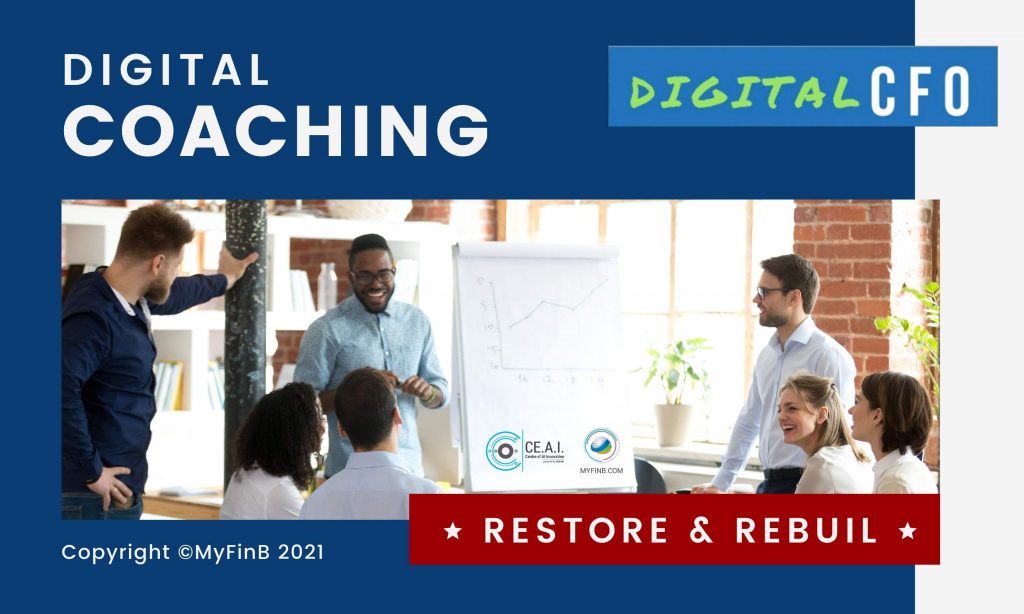With the COVID19 phenomenon impacting economies, industries and businesses globally, there is a rising need to help businesses who need strategic financial help more than ever – be it in financial restructuring, financial planning, business strategies, valuation and fund raising, just to name a few.
Find out more how you can leverage on an AI platform to create impactful solutions for your clients.
Discover new technologies that are presently deployed for advisory, coaching and mentoring
9 core needs of SMEs and the impact made
Use a digital asset to increase business performance and your firm's value: The Digital CFO platform + AI Engine + Marketplace
Newly-enhanced business model

DigitalCFO expert system is an AI-enabled analytical tool that is able to automatically converts both structured and non-structured data into detailed and narrative insights by describing the current situation, diagnosing the cause and effects, predicting and listing the potential scenarios to the situation and prescribe a set of recommendation steps to improve the situation.
Not all can afford reliable, trustworthy and capable financial experts to help the business owners and CEOs plan their finances and cashflows well.
The goal for any CFO is to help CEOs/business owners optimise their risks/returns, valuation, funding strategies and cashflow planning – in line with their business strategies and direction.
You are offered a special programme to utilise a DigitalCFO tool and a basic virtual coaching session on a cloud platform to go through the report findings.

In today’s competitive and innovation driven corporate environment, SMEs need to have a strategic outlook, be innovative in developing products, possess market development capabilities, and exhibit operational excellence in execution, amongst other things. In addition to the entrepreneurial aspects, the company will also need to learn how to undertake fund raising as well as mergers and acquisitions, which will have an impact on its growth journey.
Business valuation plays an important role in this aspect. The company will need to identify the value drivers of the business, understand their role in value creation, determine the value created, and communicate this value to the relevant stakeholders.
An in-depth study of the valuation process, approaches and methods of business valuation adopted in the market place to determine the value of businesses and companies will be carried out. This includes the focus on areas such as, the role of intellectual property in SMEs, the contributors to future economic benefits (e.g. growth and margins), factors that affect the state of the business in this new era, the strategic and operational readiness of the business and more
Using valuation to guide negotiations and decision making
Methods and techniques of business valuation
Assessing impact of strategic decisions
Implementation roadmap for your company's valuation

Running a business without comparing it to other businesses is like an athlete tracking only his/her personal best—useful to some degree, but not very challenging. The benefit of benchmarking is that it measures performance and progress. Internal benchmarking allows you to monitor various operational aspects over a period of time. It’s a valuable exercise for tracking progress, unearthing problems and identifying trends. External benchmarking gives you a more holistic view by painting a picture of where you stand in relation to competitors and similar organisations.
Financial benchmarking not only serves as a performance metric, it shines a light into dark corners and magnifies small issues that could be improved upon or corrected before they snowball into big issues. When comparing a company’s financial performance with another company or an industry benchmark, it is important to consider context as objectively as possible before drawing any conclusions.
Compare and evaluate the implications of your company's performance vs peers and industry.
Improve your business and financial strategies to deliver higher metrics over time.
Apply financial benchmarking in the areas of profitability, solvency, liquidity and efficiency of a business versus peers or industry average.
Strategic applications of financial benchmarking for SMEs.
Key pillars of financial benchmark.
Steps involved in financial benchmarking.
Benchmarking your company in each phase of your business life cycle

One of the most popular strategies for entering international markets is through joint ventures or strategic alliances – where the risks, costs, management, and success of the venture are shared by the partners. For international joint ventures and alliances, the entities are subject to many regulations and legal requirements which must be fully understood by the parties involved. Added to this are complex business and financial considerations which must be satisfied – often within the framework of a foreign culture and foreign practices. Cultural and social differences also play a large role in the success or failure of such ventures.
Growing organically is no longer sufficient or the norm. Combining forces, forming strategic partnerships and sharing resources are the way to go for SMEs to scale.
Understand the key business factors and objectives behind international joint ventures and alliances
Consider and analyse sample agreements.
Use world-class negotiation strategies to get the deal right from the outset.
Understand and draft the agreements involved.
Apply the best methods of funding international ventures.
Protect and manage existing and new technology in the venture.
Apply the management of disputes.
Deal with the post-signature practical implementation of the agreement.
Exploring different partnership models.
Structuring the venture
Managing the negotiation
Drafting the agreements
Due diligence
Developing a roadmap for partnerships / JVs for your company

Faced with limited lending options, the majority of SMEs have yet to explore the Venture Capital (VC) and Private Equity (PE) routes. There are also special public equity exchanges and crowdfunding platforms globally that cater for SMEs that aim to scale and expand their businesses to local and foreign markets. These expansion plans could entail securing more market share, develop additional lines of products, acquire new talents and support capital expenditure needs for long-term expansion.
Plan the short, medium and long-term funding needs of the business
How to prepare for funding application and invitations to financiers
Structuring funding requirements and repayment plans
Funding requirements
Preparations involved in fundraising processes / campaign(s)
Investor communication and relations
Case studies and experience sharing
Fund raising implementation roadmap

Getting loan financing from banks has become increasingly difficult as they become more selective on the type of business profile and sector they want to be exposed to. While there are alternatives to bank financing, the latter still is a useful source of funding by way of providing credit line facilities, overdrafts and trade lines.
Many SME owners will only start sourcing for financing when they face a cash flow crunch. Many of these applications will regrettably be declined by banks. Banks are in the business of managing risk and will not indiscriminately offer SME financing to companies with no clear demonstration of repayment ability.
Therefore, it is always a good practice to plan ahead and start initiating your loan applications when your company is in its best financial shape.
Identify ways to improve the bankability of your business
Position your business as an acceptable risk for the banks
Apply the “Do’s” and “Don’ts” of bank financing
Construct a good business case for financial institutions
Financing landscape in your home country and globally
Types of bank financial products: uses and risks
General lending criteria by financial institutions
Credit repair roadmap

One of the many ways for businesses to grow rapidly is through the Mergers and Acquisitions (M&A) route. There can be several scenarios and reasons for a firm to consider M&A: firstly, to increase business turnover by merging with or taking over a firm in complementary business line; increase market share by taking over a competitor; with surplus cash, more profitable opportunities can be explored by acquiring outside firms for better returns; a need for survival – loss making, declining businesses may need to make hard decisions to ensure survival and more.
M&A deals are often quite complex and challenging to complete – regardless of the size of the businesses involved. Some deals fall through before completion - and those that are completed may or may not be considered a success. Conducting a thorough investigation during the due diligence stage can help reduce the risks of failures. It is during this stage that a buyer will try to get to know, as clearly and comprehensively as possible, who the target company is – and vice versa. There are many issues to be addressed and a great deal of information to gather.
Determine the suitability of M&A strategies for your business
Establish the potential risks involved in an M&A transaction
Plan various outcomes and scenarios involved in an M&A negotiation
M&A as a strategy in your entity’s corporate strategy and growth policy
The processes involved in M&A, including target identification, due diligence, negotiation and implementation
Common tools and techniques in valuation including estimation of synergies and determination of premium
Deal structuring, financing options, including method of payments
Specific issues in corporate restructuring, private equity and leverage buyouts, cross-border acquisitions and post-merger integration
M&A roadmap for your business

Reorganisation, or business restructuring, is a process where a company does an overhaul of its current strategy, setup, and operations. When a company restructures internally, the operations, processes, departments, or ownership may change, enabling the business to become more integrated and profitable.
Restructuring can be a tumultuous, painful process as the internal and external structure of a company is adjusted and jobs are cut. But once it is completed, restructuring should result in smoother, more economically sound business operations. After employees adjust to the new environment, the company is typically better equipped for achieving its goals through greater efficiency in production. SMEs will certainly benefit from a successful, well-executed restructuring - in terms of decreasing operational costs, improved communication and decision-making processes, and also introduce new protocols and new technologies to enjoy increased operational efficiency.
Understand the different models and purposes of business structuring
Appreciate the “Do’s” and “Don’ts” of business restructuring
Pursue an effective change management strategy for your firm
Types of business restructuring models to consider
Optimal positioning in the value chain
New business model strategies
Case studies / experience sharing
Business restructuring roadmap

As business owners approach retirement age, it's never too soon to outline a succession plan. But retirement is far from the only force pushing proprietors out of ownership. Unexpected life events can happen at any age, and a succession plan ensures the right people inherit the business, operations continue to run smoothly and owners are able to exit under fair circumstances. In other words, proper succession planning is an absolute must and should begin on day one of ownership, if not before.
Proper succession planning calls for careful consideration and preparation. While it may be difficult to entertain the thought of exiting the business, unexpected circumstances can force proprietors to exit and seek new ownership immediately. Whether someone is nearing retirement age or just setting up shop, SMEs should take time now to build a succession plan that protects their business' longevity and secures their financial future.
Gain insights on how to develop a proper succession plan
Identify the obstacles of succession planning and how to overcome them
Adopt a process to develop a talent management strategy
Analyse employee data to identify talent risks
Develop a workable succession plan
Put in place implementable talent development plans
Process for developing a talent management strategy
Succession planning models and structures
Managing a succession planning process
Succession planning roadmap

One of the most popular strategies for entering international markets is through joint ventures or strategic alliances – where the risks, costs, management, and success of the venture are shared by the partners. For international joint ventures and alliances, the entities are subject to many regulations and legal requirements which must be fully understood by the parties involved. Added to this are complex business and financial considerations which must be satisfied – often within the framework of a foreign culture and foreign practices. Cultural and social differences also play a large role in the success or failure of such ventures.
Growing organically is no longer sufficient or the norm. Combining forces, forming strategic partnerships and sharing resources are the way to go for SMEs to scale.
Appreciate the strategic planning process and how these are translated into financial plans and budgets
Understand the basic principles of budget preparation and control and the importance in planning and monitoring
Build various budgets forecast +/- 10% accuracy
Understand the importance of ownership in the budget process
Identify risks of budget and forecast - pitfalls to watch for plan and forecast
Communicate with management and finance function more effectively and confidently
Strategic Planning Process - relationship between business plans, financial plans, marketing plans, operations plans, management plan and budget
Set budget goals and objectives
Planning and forecasting methodology depending on the stage of maturity of your business
Budgeting roadmap
